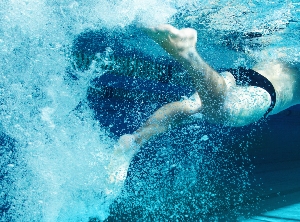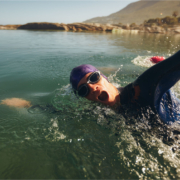Best Kickboard for Triathletes
Triathletes: To Kick or Not to Kick?
This article discusses the importance of improving your swim kick through proper training. It also explains why Ray-Board is the best kickboard for triathletes who want to improve their swim performance.
For triathletes who didn’t spend their youth on a swim team, achieving an efficient swim stroke may seem like an elusive goal. You spend hour after hour grinding away the laps, with little improvement in your split times or “feel” in the water. Even as your overall fitness improves, you’re still not becoming the fish you’d like to be.
It all starts with technique. Unless you’re already swimming near the front of the pack, you’re better off spending effort toward improving your swim form than simply muscling out yardage. And for many triathletes, a big contributor to poor form is an ineffective kick
A Quick Test
Time how long it takes to swim a length with a comfortable freestyle stroke. Then grab a kickboard and repeat the distance with only your kick.
For some of you this will be a wake-up call. Did it take you twice as long to kick that 25 or 50? If so, your kick is a major problem. You have two options: (1) Turn your kick off. If you’re not kicking, at least it can’t work against you. Or (2) fix your kick so that its playing on the same team as the rest of your body.
Plenty of triathlon coaches will suggest simply dragging your legs behind you is good enough. They argue that you have limited time in the pool each week, and they are not trying to turn you into a “real swimmer”. But wouldn’t it be nice to glide through the water with a smooth rhythmic kick, perfectly in concert with the rest of your stroke? If you’re ready to put in a little extra work to have a fully efficient stroke, then keep reading.

To improve your swim kick you’re going to need to do some kicking drills, and these means using a kickboard. If you’ve never used a kickboard you may want to learn the basics. Assuming you understand the basics, let’s discuss how kicking drills can help triathletes.
Benefit #1: Improve your Form
Problems with your kick can be disguised by a strong arm stroke, but when using a kickboard these problems are amplified and become easy to identify. For example, do you careen to one side during the kicking drill? If so, your kick is not symmetric. Are you rocking back and forth like an unstable canoe? Your core muscles are not doing a good job of stabilizing your body position.
During kicking drills, resist the urge to simply throw your effort into a higher gear. Don’t stress the clock (do you really know what a good time is for 100y kick repeats?). Instead, experiment with your form. Are your feet fully plantar flexed (toes pointed)? Are you legs moving like you’re on a bicycle (they shouldn’t be)?
Benefit #2: Increase your Strength
Are your legs spent after using the kickboard for a 25 or 50? This means that you’ve been overly reliant on your pull. It’s time to get your legs involved. The leg strength you developed as runner and cyclist doesn’t necessarily translate to a swim kick. The range of motions are different and swimming involves some different muscles. Consistently doing kicking drills will build that strength.
Initially you may not be able to kick for very long. Try mixing in short kicking drills several times throughout your workout. This isolates your let muscles, but then allows them to recover. As you gain strength and endurance, try longer kick sets. If you put an extended kick session at the end of the workout you can consider it a mini “all-swim” brick workout.
Benefit #3: Add Some Variety
Triathletes typically excel at being in their own heads for hours at a time. In the pool its not uncommon to see a triathlete swim their entire workout head in the water at a steady pace. But as discussed, that’s not the best use of your pool time. Competitive swimmers frequently switch up strokes. This allow for muscle and mental recovery, letting them swim at a higher level of exertion. This is more challenging for triathletes since many don’t swim multiple strokes. Kicking a 100-200 several times during a workout can provide mental break that allows you to refocus your effort.
So if you’re now bought into trying a few kick sets you may find yourself asking “Are there different types of kickboards?” There are likely a couple dozen kickboards in a damp closet at your local pool. Before you grab one and start kicking, consider this: triathlon coach John Wood wrote in an article on 220triathlon.com:
“The main reason that I don’t use kickboards while swimming or coaching is that it promotes a poor body position. Wherever your hands sit on a float, your shoulders will be raised out of the water somewhat (which can put stress on the muscles and joints).”
So now what? How do I practice my kicking if kickboards are part of the problem? Is there a kickboard that promotes good body position and doesn’t stress your shoulders and neck?
Meet Ray-Board™ – The Best Kickboard for Triathletes
Ray-Board is the preferred kickboard of triathletes and competitive swimmers. It was designed to address all of the concerns listed by coach Wood. It’s unique shape lowers your elbows to a more natural and comfortable position that promotes horizontal body alignment. This puts your legs in the proper position without having to arch your back and crane your neck. The design even allows you to swim with your head in the water as you would with a normal swim stroke. When using Ray-Board you focus on the kicking drill, not on trying to find a comfortable position and counting the seconds until the drill is over. Are you ready to start using the best kickboard for triathletes?




